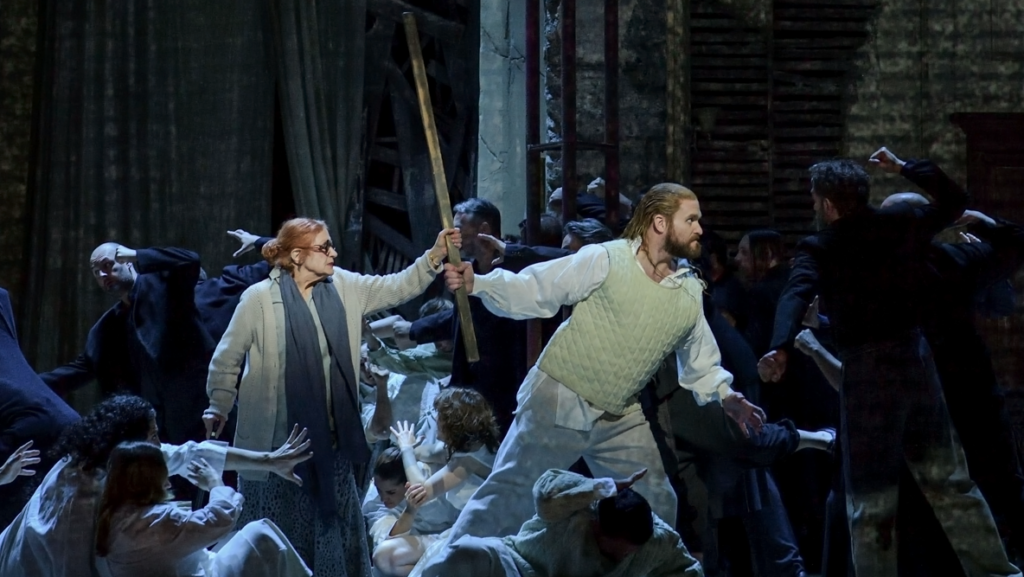
Stefan Brion
All three are linked, as Rameau reused music from the aborted Samson in each of the others. Samson, as presented by Raphaël Pichon and Claus Guth, is not an attempt to reconstitute the original, about which too little is known for sure. It is rather, as they make clear, an attempt to revive the spirit of Samson in the form of a contemporary recreation.
The result was presented last summer at the Aix festival, so the story of both Rameau and Voltaire’s Samson, and Pichon and Guth’s take on it, was told many times over back then. But just in case, I’ll try to sum it up, and if you’re already in the know, you can just hop, skip (several paragraphs), and jump to my account of this year’s revival at the Opéra Comique.
Before the premiere of Hippolyte et Aricie, in October 1733, Voltaire had supposedly never heard of Rameau. The day after, in a letter, he dismissed the composer as a boring pedant. Yet, in a remarkable about-face, by November he was already at work on Samson, having decided, following the growing success of Hippolyte, that Rameau was just the composer he needed to reform French opera by stripping it of sycophantic prologues, long recitatives, irrelevant divertissements, and mandatory happy ends. Prefiguring Gluck, he proposed they “make a revolution together, because opera has lost its way in the meanders of entertainment,” instead of taking its cues from the likes of Racine by “asking the big questions” and helping us better apprehend the world we live in.
The first version of Samson, text and score, was ready in 1734. However, the timing was bad: that same year, Voltaire’s Lettres Philosophiques were condemned to be slashed and burnt in public, while Voltaire slipped out of Paris to lie low in the sticks for a while. And the choice of a biblical subject – a surprising one on the part of both Voltaire and Rameau, neither of them known for their piety – led to its rejection by the censors for perverting the biblical texts and mixing the sacred and the profane. Voltaire’s slant is summed up as follows on the Opéra Comique’s website:
Samson can be understood as a challenge to religion. The author shows the absurdity of the wars between the Hebrews and the Philistines and condemns all violence perpetrated in the name of God. The vengeful, destructive God of the Old Testament appears even more terrible than those of the Philistines. Samson is presented as a bloodthirsty barbarian as much as a saviour. His election – and that of his people – which results in exclusion and sacrifice, is itself ambiguous. Voltaire thus denounces the absurdity of grace based on eternal suffering.
The success, in 1735, of Les Indes Galantes, nevertheless prompted Voltaire to have another stab at Samson, even though Rameau had already begun recycling the music, in Les Incas du Pérou. Together, in 1736, they completed a second version, but again, it was rejected by the censors. Rameau never published a score or deposited one, for posterity, with the Académie Royale. He preferred to recycle the music over the years, not just in Les Indes Galantes, but, as far as can be ascertained, in Castor et Pollux, Les Fêtes d’Hébé, Zoroastre, La Princesse de Navarre, Le Temple de la Gloire, and no doubt others.
To create the new Samson, Claus Guth went back to the Book of Judges to construct, with the support of a dramaturg and a librettist, a contemporary drama based on the character’s full life-story, rather than just the part we all know best from, say, Saint-Saëns. Meanwhile, Raphaël Pichon researched and selected music known, or at least thought, to have been composed for Samson, along with other Rameau pieces he felt were in the spirit of the new scenario and text – based, as I understand it, only partially on Voltaire’s toned-down published version (1745). Director and conductor worked together, back-and-forth and apparently right up to the 2024 premiere, to arrive at their final product, in a manner that echoes, 300 years on, the toing-and-froing and give-and-take between Voltaire and Rameau in the course of their various collaborations – or indeed, the engrossing correspondence between Hofmannsthal and Strauss.

Guth’s production – like Voltaire’s text – adapts the biblical tale, rather than telling it straight. His focus is on the story of a senseless yet deadly conflict between two peoples, and of a troubled, hesitant, contemporary hero-malgré-lui, struggling to live up to his destiny. It raises issues of oppression, faith and the dead end of the fanaticism it leads to.
The single set is the impressively realistic ruin of a neoclassical mansion. There are openings towards a window and a curtained exit on the left, and a staircase with a wrought-iron banister to the right; the high ceiling is shored up with steel poles in the middle, with a tangle of charred carpentry above. This wreck could be anywhere, though the designs in the plasterwork seemed to me to evoke the Middle East. Samson has killed himself, along with the Philistines, in a suicide bombing – his “last act of cruelty,” Guth calls it.
To amplified sound effects, which, loud or soft, will be a feature of the production throughout, workmen and an architect inspect the ruin, parts of which are cordoned off with red-and-white striped plastic ribbon. A tramp who, we discover later, is a sort of religious maniac, yelling biblical imprecations, drags his blanket around, looking for a quiet place to sleep, and an old woman enters: Samson’s mother, a spoken role. Trying to get her head around what’s happened, she begins to tell her son’s story from the start, helped, as the production progresses, by quotations from Judges and Isaiah displayed on a half-fallen rafter.
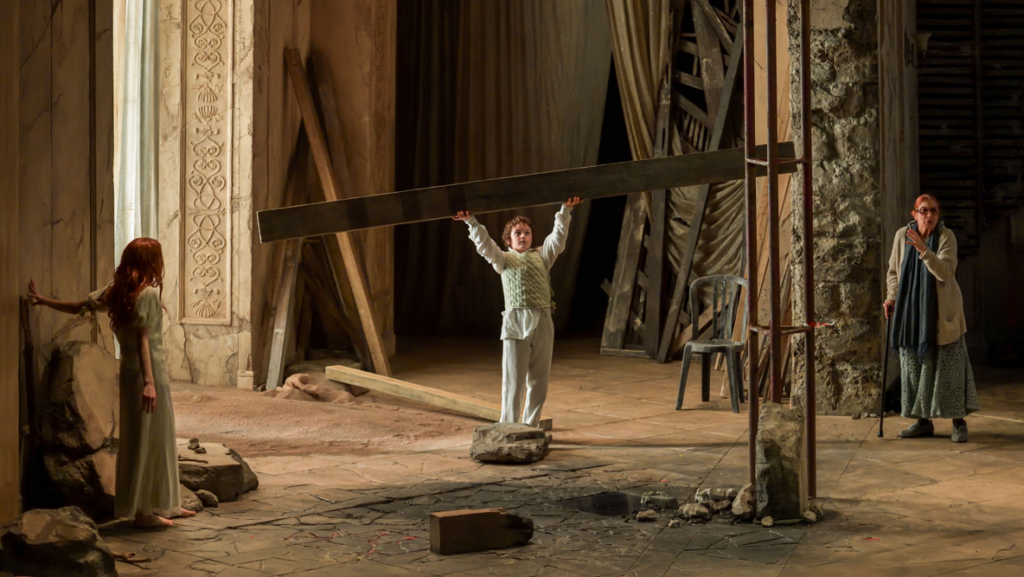
Stefan Brion
We meet young Samson (a child actor) already sporting a mullet and toying with heavy wooden beams, before witnessing his first affair, with a Philistine girl, Timna. Their wedding is tense, to say the least. Throughout this production, the two communities are at daggers drawn, and Philistine leader Achisch is portrayed as an evil, viciously sadistic tyrant egging his community on to bloody violence. The Hebrews wear white, the Philistines black; only ‘defectors,’ crossing the line, wear a bit of both. The costumes are, to my eye, just a little bit too trendy, a clever mix of natty eighteenth-century tailoring (high-collared habits), oriental details (jackets over shalvar ‘harem pants’), and Rick Owens (lots of layers, and pleated skirts over men’s trousers). As a result, the frequent violent clashes that break out between the two sides – artfully choreographed in stop-motion with strobe lights and sound effects, dancers and chorus inextricably mingled – come close to looking like a fashion-week catfight, luvvie fashionistas scrapping over the last pair of Balenciagas.
The lighting, by the way, is notably sophisticated. A horizontal neon is lowered and raised, like a virtual curtain, to mark pauses between Acts, vertical lasers, green and red, scan the sets at critical nodes, and an intriguingly clever projection or hologram poetically conjures up swarming bees, as Samson draws honey from the lion’s carcass.
The absence of recitatives, the pauses for sound effects, the slow-motion fighting, the insertion of spoken passages and projected quotations all, of course, contribute to a sense of fragmentation. The first part of the production, up to the break, thus comes across as a bit slow-moving; it could probably be tightened up in future. But after the break, once Delilah is with us, things liven up, to say the least. The action turns into a crescendo of violence of Jacobean bloodiness. After a love scene, and the fateful trim, on an iron bedstead wheeled out under a chandelier, Samson is chained to it to have his eyes put out. The sheets are then drenched in blood, so much so that Delilah is able to smear herself with it as, gruesomely, she opens her veins in remorse (more blood), singing ‘Tristes apprêts’. Samson’s treacherous friend Elon (yes, Elon, a character added by Guth and Pichon, who felt a haute contre role was called for) then has his throat slit before Samson brings the house down in an explosion of strobes and thunderous sound – to the music reused by Rameau for the volcanic eruption in Les Indes Galantes.
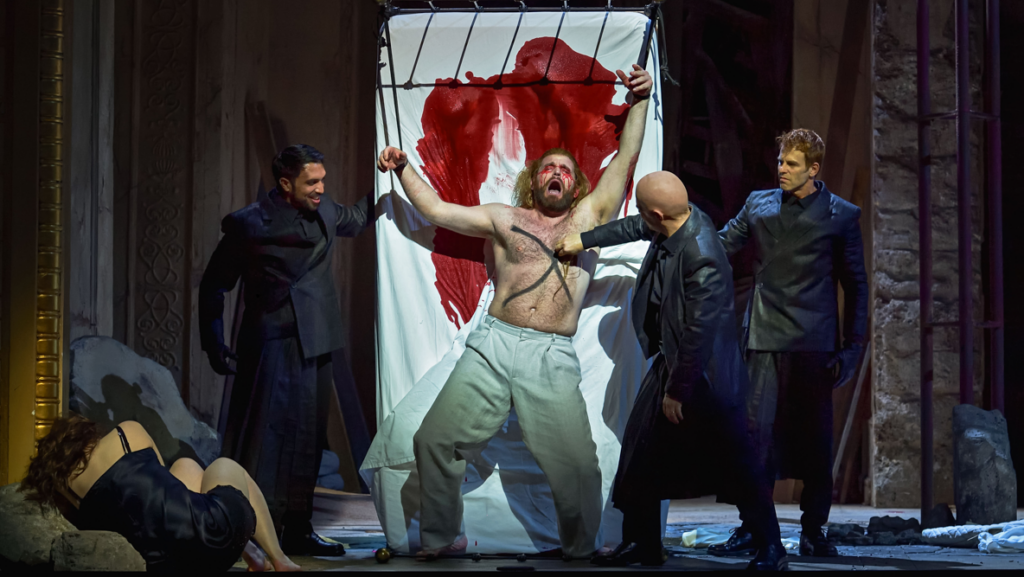
Stefan Brion
Then a long silence, and applause. First out is Samson himself. This makes sense, as the role really dominates Guth and Pichon’s show. Like Salome, Samson is on stage nearly all the time, and the production makes demands on Jarrett Ott, from acting the tortured antihero to outright, head-over-heels acrobatic fantasy and ending in total gore, that had me thinking back to the extraordinary performance Romeo Castellucci elicited from Scott Hendricks in Das Rheingold in Brussels. Ott was in very fine voice on Wednesday evening and deserved the ovation he got.
The other ‘big’ part in this piece is Delilah’s. Ana Maria Labin was new to me, but I see she sings a lot of Händel and Mozart with all the usual baroque suspects: Christie, Bicket, Spinosi, Herreweghe, now Pichon… I must say I’d be very happy to see her again in either, as she combines a very seductive, juicy soprano voice with radiant presence and excellent, seemingly natural, acting skills.
The other parts are a good deal smaller, so it was hard to form a substantial opinion of the voices, on this occasion, of Julie Roset or Camille Chopin, other than that they were small but sweet. The angel, by the way, has just one white wing, like all angels in contemporary productions; I don’t know why.
When I first saw Mirco Palazzi, fifteen years ago in Palermo, I found him a ‘very interesting bass (…) with surprisingly clear, articulate, in-tune bottom notes, down in the Sarastro basement area.” Here he made a suitably dark Achisch, but those bottom notes are now hollowed out, so his performance overall was curate’s-eggy.
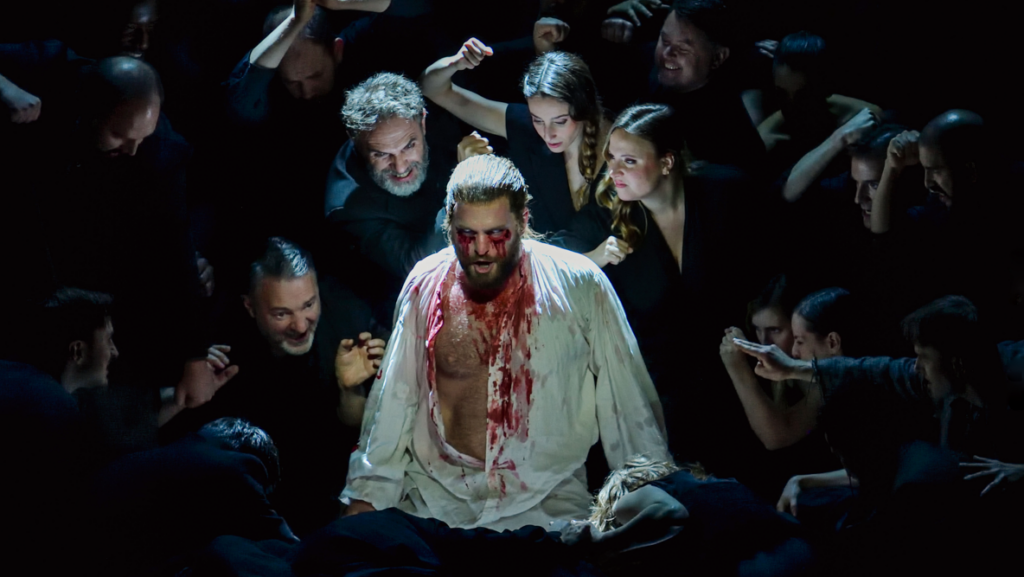
Stefan Brion
Laurence Kilsby, recently a spellbinding Amour in the Paris Opera’s Castor et Pollux, is rapidly making quite a name for himself in Paris and no doubt elsewhere. The invented role of Elon, calling for a lot of agitation at the top, didn’t, however, play to his strengths, which are probably more lyrical. Better luck next time. Among the supporting cast, however, Cuban baritone René Ramos Premier stood out, albeit briefly. Though short, his contribution was noticeable enough, vocally and in terms of glowing presence, for me to want to make a note of it here.
Many ‘HIP’ ensembles have now reached a degree of perfection not always found in the more traditional opera-house pit (which is, incidentally, why we’re sometimes surprised by the feeble ‘baroque’ voices chosen to sing on stage with them). Raphaël Pichon’s Pygmalion orchestra and chorus are among them. Their virtuosity allows Pichon to take remarkable liberties with the score, straying into post-’HIP’ Currentzian audacity with, for example, extreme changes of tempo and dynamics verging on mannerism.

His chorus manages to remain spot-on while, we imagine, trotting from pit to stage to somewhere very far off in the house, whence their singing was as faint as could be, a ghostly, disembodied echo. He uses a large orchestra, with over 30 strings, so I read, and so probably as large as any Rameau had himself heard. Many reviewers have commented on the startlingly powerful sound they produced. None has suggested it was amplified to hold its own against the spoken texts and sometimes thunderous sound-effects, but I see that when Samson was premiered in Aix, a couple of posters on the French forum, ODB Opéra, suspected it was. I did, too, and so did my neighbor this week.
If we look at Samson in conventional operatic terms, it might seem, with its silences, spoken passages, sound effects, projections and stylized battles, disjointed and – up to the interval at least – lacking true dramatic thrust. But the production forms, overall, a very handsome object indeed. I’d personally say Guth and Pichon have succeeded in creating a convincing contemporary work that stands on its own, singular feet as such. Whether or not this festival creation is suitable for frequent revival as a repertoire piece is another question. But you can judge for yourself: as I write, the Aix video is still available on the Arte TV website and above, and will remain so for some time.
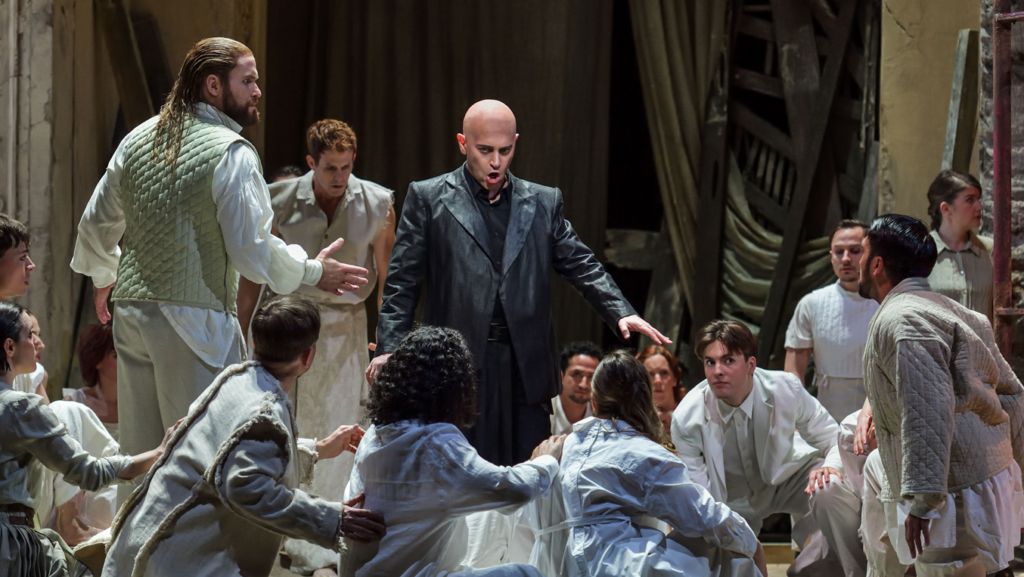


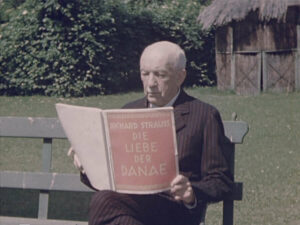


Comments